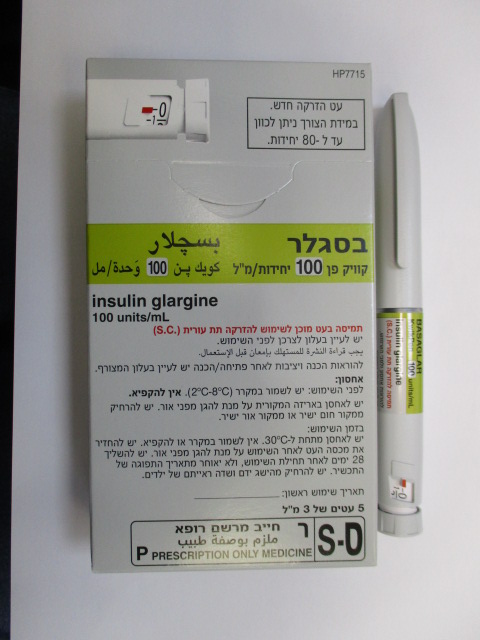Quest for the right Drug

בסגלר BASAGLAR (INSULIN GLARGINE)
תרופה במרשם
תרופה בסל
נרקוטיקה
ציטוטוקסיקה
צורת מתן:
תת-עורי : S.C
צורת מינון:
תמיסה להזרקה : SOLUTION FOR INJECTION
עלון לרופא
מינוניםPosology התוויות
Indications תופעות לוואי
Adverse reactions התוויות נגד
Contraindications אינטראקציות
Interactions מינון יתר
Overdose הריון/הנקה
Pregnancy & Lactation אוכלוסיות מיוחדות
Special populations תכונות פרמקולוגיות
Pharmacological properties מידע רוקחי
Pharmaceutical particulars אזהרת שימוש
Special Warning עלון לרופא
Physicians Leaflet
Posology : מינונים
4.2 Posology and method of administration Posology Basaglar contains insulin glargine, an insulin analogue, and has a prolonged duration of action. Basaglar should be administered once daily at any time but at the same time each day. The dose regimen (dose and timing) should be individually adjusted. In patients with type 2 diabetes mellitus, Basaglar can also be given together with orally active antidiabetic medicinal products. The potency of this medicinal product is stated in units. These units are exclusive to Basaglar and are not the same as IU or the units used to express the potency of other insulin analogues (see section 5.1). Special population Elderly population (≥65 years old) In the elderly, progressive deterioration of renal function may lead to a steady decrease in insulin requirements. Renal impairment In patients with renal impairment, insulin requirements may be diminished due to reduced insulin metabolism. Hepatic impairment In patients with hepatic impairment, insulin requirements may be diminished due to reduced capacity for gluconeogenesis and reduced insulin metabolism. Pediatric population Safety and efficacy of Basaglar have been established in adolescents and children of 6 years and above. In children, efficacy and safety of Basaglar have only been demonstrated when given in the evening. Due to limited experience on the efficacy and safety of Basaglar in children below the age of 6 years, Basaglar should only be used in this age group under careful medical supervision. Switch from other insulins to Basaglar When switching from a treatment regimen with an intermediate or long-acting insulin to a regimen with Basaglar, a change of the dose of the basal insulin may be required and the concomitant antidiabetic treatment may need to be adjusted (dose and timing of additional regular insulins or fast-acting insulin analogues or the dose of oral antidiabetic medicinal products). Switch from twice daily NPH insulin to Basaglar To reduce the risk of nocturnal and early morning hypoglycemia, patients who are changing their basal insulin regimen from a twice daily NPH insulin to a once daily regimen with Basaglar should reduce their daily dose of basal insulin by 20-30% during the first weeks of treatment. Switch from insulin glargine 300 units/ml to Basaglar Basaglar and Toujeo (insulin glargine 300 units/ml) are not bioequivalent and are not directly interchangeable. To reduce the risk of hypoglycemia, patients who are changing their basal insulin regimen from an insulin regimen with once daily insulin glargine 300 units/ml to a once daily regimen with Basaglar should reduce their dose by approximately 20%. During the first weeks the reduction should, at least partially, be compensated by an increase in mealtime insulin, after this period the regimen should be adjusted individually. Close metabolic monitoring is recommended during the switch and in the initial weeks thereafter. With improved metabolic control and resulting increase in insulin sensitivity a further adjustment in dose regimen may become necessary. Dose adjustment may also be required, for example, if the patient'’s weight or life-style changes, change of timing of insulin dose or other circumstances arise that increase susceptibility to hypo- or hyperglycemia (see section 4.4). Patients with high insulin doses because of antibodies to human insulin may experience an improved insulin response with Basaglar. Method of administration Basaglar is administered subcutaneously. Basaglar should not be administered intravenously. The prolonged duration of action of Basaglar is dependent on its injection into subcutaneous tissue. Intravenous administration of the usual subcutaneous dose could result in severe hypoglycemia. There are no clinically relevant differences in serum insulin or glucose levels after abdominal, deltoid or thigh administration of Basaglar. Injection sites must be rotated within a given injection area from one injection to the next in order to reduce the risk of lipodystrophy and cutaneous amyloidosis (see section 4.4 and 4.8). Basaglar must not be mixed with any other insulin or diluted. Mixing or diluting can change its time/action profile and mixing can cause precipitation. For further details on handling, see section 6.6. Before using Basaglar solution for injection in pre-filled pen, the instructions for use included in the package leaflet must be read carefully (see section 6.6).

פרטי מסגרת הכללה בסל
התרופה תינתן לחולי סוכרת
מסגרת הכללה בסל
התוויות הכלולות במסגרת הסל
| התוויה | תאריך הכללה | תחום קליני | Class Effect | מצב מחלה |
|---|---|---|---|---|
| INSULIN GLARGINE | ||||
| INSULIN DETEMIR | ||||
| סכרת |
שימוש לפי פנקס קופ''ח כללית 1994
לא צוין
תאריך הכללה מקורי בסל
15/04/2005
הגבלות
תרופה מוגבלת לרישום ע'י רופא מומחה או הגבלה אחרת
מידע נוסף
עלון מידע לרופא
15.12.21 - עלון לרופאעלון מידע לצרכן
13.08.20 - עלון לצרכן אנגלית 13.08.20 - עלון לצרכן ערבית 21.12.21 - עלון לצרכן אנגלית 11.08.20 - עלון לצרכן עברית 21.12.21 - עלון לצרכן עברית 21.12.21 - עלון לצרכן ערבית 03.06.20 - החמרה לעלון 08.07.20 - החמרה לעלון 11.08.20 - החמרה לעלון 13.08.20 - החמרה לעלון 01.10.20 - החמרה לעלון 02.09.21 - החמרה לעלון 15.12.21 - החמרה לעלוןלתרופה במאגר משרד הבריאות
בסגלר